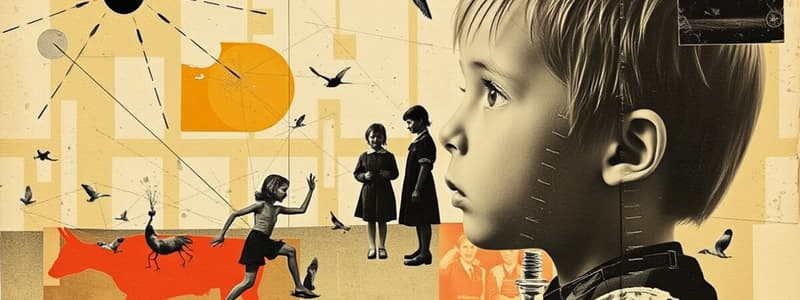Podcast
Questions and Answers
At what age do most children begin to use correct word order and grammatical markers most of the time?
At what age do most children begin to use correct word order and grammatical markers most of the time?
- Four years old (correct)
- Two years old
- Three years old
- Five years old
Children learn complex linguistic structures like passives and relative clauses only after they turn five.
Children learn complex linguistic structures like passives and relative clauses only after they turn five.
False (B)
What is meant by metalinguistic awareness?
What is meant by metalinguistic awareness?
The ability to treat language as an object separate from the meaning it conveys.
By the age of four, most children can ask questions, give commands, and create _____ about imaginary events.
By the age of four, most children can ask questions, give commands, and create _____ about imaginary events.
Match the following age milestones with their corresponding language features:
Match the following age milestones with their corresponding language features:
What is a significant factor in the development of metalinguistic awareness?
What is a significant factor in the development of metalinguistic awareness?
Children learn thousands of new words during their early school years.
Children learn thousands of new words during their early school years.
What language register changes do children learn during the school years?
What language register changes do children learn during the school years?
What is the earliest form of vocalization in babies?
What is the earliest form of vocalization in babies?
Babies can distinguish between the voices of their mothers and other speakers.
Babies can distinguish between the voices of their mothers and other speakers.
At what age do most babies begin to produce a word or two that everyone recognizes?
At what age do most babies begin to produce a word or two that everyone recognizes?
By the age of two, most children reliably produce at least ___ different words.
By the age of two, most children reliably produce at least ___ different words.
What term is used to describe simple sentences that omit certain parts of speech?
What term is used to describe simple sentences that omit certain parts of speech?
Babies learn language effectively from electronic devices alone.
Babies learn language effectively from electronic devices alone.
Match the following developmental milestones with the corresponding ages:
Match the following developmental milestones with the corresponding ages:
Babies wave when someone says '___'.
Babies wave when someone says '___'.
Flashcards are hidden until you start studying
Study Notes
Early Language Acquisition
- Developmental sequences in first language acquisition describe patterns seen in early vocalizations, starting with involuntary crying due to hunger or discomfort.
- Initial cooing and gurgling sounds occur as infants express contentment while observing their surroundings.
- Infants show remarkable auditory discrimination, recognizing subtle differences in sounds and distinguishing their mother's voice and the language spoken around them during gestation.
- Interaction with human speakers is crucial for infants to learn and retain language sounds; exposure through electronic devices is insufficient.
Milestones in Language Understanding
- By the end of their first year, infants typically understand common words and phrases, responding to cues like 'bye-bye' and 'juice and cookies.'
- At 12 months, many infants begin to produce recognizable words, while by age two, they can say at least 50 words and form simple sentences known as telegraphic speech, omitting function words but maintaining meaningful structure.
Developmental Sequences and Cognitive Relations
- Predictable patterns emerge in language feature development, linked to cognitive growth; for example, understanding of temporal adverbs takes cognitive maturity.
- By age four, children can ask questions, give commands, and narrate events with appropriate grammar, indicating mastery of basic language structures.
Vocabulary Growth and Language Complexity
- Three- and four-year-olds learn several new words daily and start to grasp complex structures like passives and relative clauses.
- Metalinguistic awareness develops, enabling young children to recognize nonsensical phrases, distinguishing between language form and meaning.
Impact of Literacy on Language Development
- Learning to read enhances metalinguistic awareness, as children start realizing that language exists in both form and meaning through written symbols.
- Children enter school with thousands of words in their vocabulary, and continue to expand their lexicon through classroom exposure to various contexts.
Language Registers and Contextual Learning
- School-age children learn to navigate different language registers, understanding how language varies between formal and informal contexts, such as speaking with a principal versus peers on the playground.
Studying That Suits You
Use AI to generate personalized quizzes and flashcards to suit your learning preferences.




